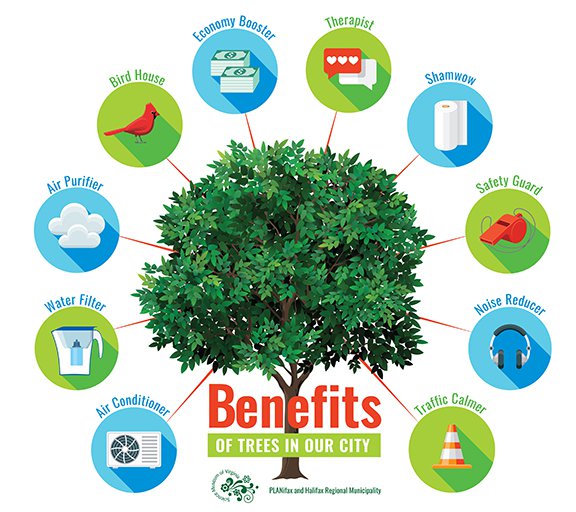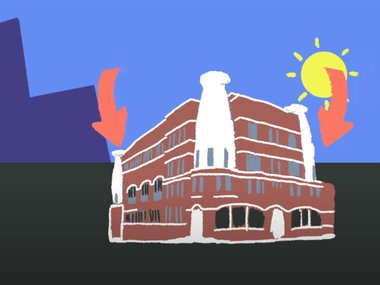Trees Are Cool!
Is your air conditioner running? Then you’d better go catch it!
Ok, in all seriousness, we’re about to state the obvious but here goes: it’s summer in Virginia, which means it’s hot. And when it’s steamy outside, we use energy inside to cool us down. Energy prices keep going up, so let’s turn to ways we can utilize nature’s air conditioner. That’s right, we’re talking about trees and plants!
Whether you’re looking at a smaller space like your yard or an entire community, trees make a big impact. Studies have shown trees can help reduce a city’s temperature by as much as 16°F. And positioning trees in just the right way around your yard can cut up to 25% of a household’s annual electricity usage. So, how do trees work their magic? Easy: it’s science!

An image of the Science Museum's Dome Plaza

An image of the Science Museum's Dome Plaza as seen through a thermal camera
Trees cool the air by absorbing and diffusing the Sun's radiation on its way toward the ground. Shaded surfaces may be 20-45°F cooler than those same surfaces in direct sunlight. We can see this effect on the Science Museum of Virginia’s own Dome Plaza in the images featured above.
It’s easy to recognize that trees throw shade, but what’s less obvious is the process of air conditioning through transpiration. Meaning, just like you sweat in the Virginia heat, so do trees!
During transpiration, liquid water is absorbed by the plant’s roots, flows up through the plant’s tissues and finally arrives in its leaves where the Sun’s heat causes the water to evaporate. As water evaporates, energy is removed from the surrounding air in the form of heat (known as an endothermic reaction). This removal of heat has the effect of cooling the surrounding air. In fact, transpiration can help lower peak summer temperatures by 2-9°F!
In most plant species, virtually all of the water entering the roots is lost in the form of transpired water vapor from leaves, and this can be a lot of water. It’s estimated that a single silver maple tree transpires as much as 58 gallons per hour. A large oak tree can transpire 40,000 gallons per year. That means you’d only need 16 oak trees to transpire an Olympic swimming pool’s worth of water in a year. WHOA! Check out that water cycle in action, y’all!
The transpiration process works well when there’s water in the soil. However, during severe droughts, transpiration cooling can be drastically reduced.

Want to increase your natural cooling system around your home? Then increase the amount of vegetation! The more of your yard that’s covered by green leaves, the more transpiration will be happening. This means not only adding more plants, but also taking care of the ones you have.
Laying 2-3” of mulch around the base of perennials, or the plants that come back year after year, and within the dripline of trees, the area under the branches, will help maintain water content in the soil and improve the soil with organic matter. Remember: don’t build a mulch volcano with the plant erupting out of the center. Instead, spread the mulch like a skinny tire or a flat donut so there’s a dip in the middle where the bark isn’t directly next to the tree trunk. That will help keep water from running away from the tree. Plus, leaving a small gap will decrease the chances of rot by not having wet mulch up against the bark.
In order to increase cooling from shade, plant deciduous trees, or trees that shed their leaves each year, to the south and west of your home. Trees that shade windows and part of a building’s roof provide the greatest cooling impact. Research conducted at Auburn University found that the combination of air conditioning and 17% shade on your house will decrease your power bill by $10 per summer month. If shade were to increase to 50% over your house, this translates to a savings of $30 per month. Now, that just makes cents!
Here’s a really important part that’s worth remembering: the right tree + the right location = the key to maximizing the energy-savings benefit trees provide. For help choosing the most beneficial location for your trees, try using the i-Tree software from the USDA Forest Service.
Maybe you’ve heard this one: the best time to plant a tree was yesterday; the second best time is today. Well, actually the best time to plant a tree around Virginia is in the fall. But don’t wait! Go ahead and start looking for the perfect place to plant trees and start researching species to plant now so you’ll be ready to celebrate come October when Richmond hosts Arbor Day.
We’ll leaf it at that so you can dig in. Happy planting!

